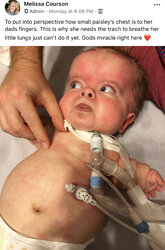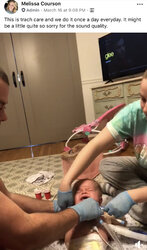MiniMuffin
kiwifarms.net
- Joined
- Feb 10, 2019
I found an update about Paisley, the baby with Thanatophoric Dwarfism, aka Thanatophoric Dysplasia, whom Bubblez McGee mentioned back in February. Her family was able to bring her home eventually and have a Facebook page called (of course) Prayers for Paisley.
Now, in still photos the baby is sort of cute:

However her chest is devastatingly small compared to the rest of her. You can see why she can’t breathe properly:

“Her little lungs can’t do it yet” AND THEY NEVER WILL MELISSA. Her proportions are stuck that way; that’s the nature of her condition.
For some long term perspective I found this medical journal article about an almost unheard-of case of a child with this condition who lived to adulthood. This is what Paisley and her parents have to look forward to:

A is at age 4, B is when she was in her early teens and at the peak of her motor abilities, C is at 22 “with pronounced tongue hypertrophy” and D is “extensive acanthosis nigricans with papillomatous elevations” at age 26. [EDITED to add:] That’s a skin condition associated with diabetes and hormone disorders.
And here’s Paisley getting trach care. It’s a screenshot of a video from the Facebook group. Paisley was lying there looking fine until they sat her up and then she started wailing. Or trying to wail. On the sound in the video the loudest noise she could make was a tiny squeak, not even as loud as a kitten.

What a wretched life.
Edited for typos.
Now, in still photos the baby is sort of cute:

However her chest is devastatingly small compared to the rest of her. You can see why she can’t breathe properly:

“Her little lungs can’t do it yet” AND THEY NEVER WILL MELISSA. Her proportions are stuck that way; that’s the nature of her condition.
For some long term perspective I found this medical journal article about an almost unheard-of case of a child with this condition who lived to adulthood. This is what Paisley and her parents have to look forward to:
A is at age 4, B is when she was in her early teens and at the peak of her motor abilities, C is at 22 “with pronounced tongue hypertrophy” and D is “extensive acanthosis nigricans with papillomatous elevations” at age 26. [EDITED to add:] That’s a skin condition associated with diabetes and hormone disorders.
She was able to breathe independently with supplemental oxygen until 2 months of age, when she acquired a respiratory infection. Cranial imaging demonstrated a small foramen magnum. She went on to have cervicomedullary decompression for this stenosis and also received a ventriculoperitoneal shunt. She managed her own respiration until 4 months of age when she required ventilation support. Between the ages of 8 and 10 years, she could be off the ventilator for up to 8 hours on most days. She then developed increased work of breathing due to restrictive lung disease and could only be ventilator‐free for 30‐min intervals until age 15 years when she became fully dependent. This was further compromised due to the progression of her craniocervical spinal stenosis, causing a high cervical myelopathy and quadriplegia. A magnetic resonance imaging study at 18 years did not demonstrate any cerebrospinal fluid flow through the foramen magnum. No further decompression surgeries were attempted. Within the last year, her needs from the ventilator have progressed so that she has now reached the upper limits of tolerable ventilation settings.
At her motor “peak”, she was able to feed herself popsicles, give “high‐5's”, roll, move around on her abdomen, lift her feet so that they could be kissed and position her head so she could use her tongue to play with toys. Her tongue hypertrophied as she used it as an appendage (Fig. 1). A developmental assessment in her late teens rated her social, language and motor skills at between an 8–18 month level. At 21 years of age, she was no longer able to use her limbs, was unable to lift her head and could only turn it to the right. She has some vocalizations that her mom can associate with specific concepts or things and uses winking for communication. She knows her caregivers and makes her likes and dislikes known. The loss of many of her capabilities was attributed to the quadriplegia, although there is a feeling among her care providers that she may have declined cognitively as well...
She is fed orally with purees and thickened fluids and has occasional episodes of constipation for which she in on a bowel regime consisting of medical therapy and enema. She has an intact gag reflex and a formal swallowing study was reported as normal. She has a very high narrow palate and prognathism. Her dentition is irregular but there are no caries....
She has intermittent exotropia. She has a cholesteatoma in her right ear that has been stable in size but has impacted her hearing. She last had her hearing formally assessed in her late teens at which time significant impairment was noted. However, she recognizes voices and reacts to sounds.
At her motor “peak”, she was able to feed herself popsicles, give “high‐5's”, roll, move around on her abdomen, lift her feet so that they could be kissed and position her head so she could use her tongue to play with toys. Her tongue hypertrophied as she used it as an appendage (Fig. 1). A developmental assessment in her late teens rated her social, language and motor skills at between an 8–18 month level. At 21 years of age, she was no longer able to use her limbs, was unable to lift her head and could only turn it to the right. She has some vocalizations that her mom can associate with specific concepts or things and uses winking for communication. She knows her caregivers and makes her likes and dislikes known. The loss of many of her capabilities was attributed to the quadriplegia, although there is a feeling among her care providers that she may have declined cognitively as well...
She is fed orally with purees and thickened fluids and has occasional episodes of constipation for which she in on a bowel regime consisting of medical therapy and enema. She has an intact gag reflex and a formal swallowing study was reported as normal. She has a very high narrow palate and prognathism. Her dentition is irregular but there are no caries....
She has intermittent exotropia. She has a cholesteatoma in her right ear that has been stable in size but has impacted her hearing. She last had her hearing formally assessed in her late teens at which time significant impairment was noted. However, she recognizes voices and reacts to sounds.
And here’s Paisley getting trach care. It’s a screenshot of a video from the Facebook group. Paisley was lying there looking fine until they sat her up and then she started wailing. Or trying to wail. On the sound in the video the loudest noise she could make was a tiny squeak, not even as loud as a kitten.

What a wretched life.
Edited for typos.
Last edited:

